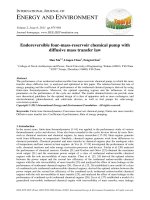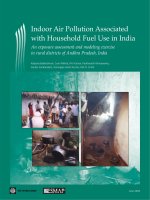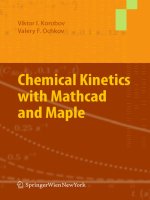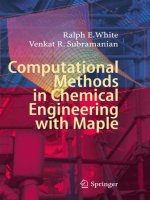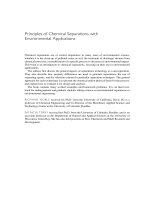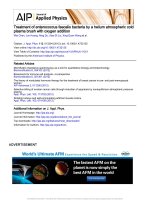Validation of chemical looping with oxygen uncoupling (CLOU) using cu based oxygen carrier and comparative study of cu, mn and co based oxygen carriers using ASPEN plus
Bạn đang xem bản rút gọn của tài liệu. Xem và tải ngay bản đầy đủ của tài liệu tại đây (817.57 KB, 8 trang )
INTERNATIONAL JOURNAL OF
ENERGY AND ENVIRONMENT
Volume 6, Issue 3, 2015 pp.247-254
Journal homepage: www.IJEE.IEEFoundation.org
ISSN 2076-2895 (Print), ISSN 2076-2909 (Online) ©2015 International Energy & Environment Foundation. All rights reserved.
Validation of chemical-looping with oxygen uncoupling
(CLOU) using Cu-based oxygen carrier and comparative
study of Cu, Mn and Co based oxygen carriers using
ASPEN plus
Xiao Zhang, Subhodeep Banerjee, Ramesh K. Agarwal
Department of Mechanical Engineering & Materials Science, Washington University in St. Louis,
1 Brookings Drive, St. Louis, MO 63130, USA.
Abstract
The chemical-looping with oxygen uncoupling (CLOU) has been demonstrated to be an effective
technological pathway for high-efficiency low-cost carbon dioxide capture when particulate coal serves
as the fuel. In this paper, complete process-level modeling of CLOU process conducted in ASPEN Plus
is presented. The heat content of fuel and air reactors and air/flue gas heat exchangers is carefully
examined. It is shown that the established model provides results which are in excellent agreement with
the experiments for the overall power output of the CLOU process. Finally the effect of varying the air
flow rate and three different types of coal as the solid fuel on energy output is investigated, and the
performance of three – Copper (Cu), Manganese (Mn) and Cobalt (Co) based oxygen carriers in CLOU
process is compared. It is shown that there exists an optimal air flow rate to obtain the maximum power
output for a given coal feeding rate and coal type. The effect of three different oxygen carriers on energy
output is also investigated using the optimal air flow rate. Among the three oxygen carriers - CuO,
Mn
2
O
3
, and Co
3
O
4
; Mn
2
O
3
shows the best performance on power output. The results presented in this
paper can be used to estimate the amount of various quantities such as the air flow rate and oxygen
carrier (and its type) required to achieve near optimal energy output from a CLOU process based power
plant.
Copyright © 2015 International Energy and Environment Foundation - All rights reserved.
Keywords: Carbon-dioxide capture; Chemical-looping combustion; Oxygen decoupling; Process
simulation.
1. Introduction
Chemical-lopping combustion (CLC) is an emerging and highly promising technology that can produce a
pure stream of CO
2
[1, 2]; it requires much less energy for CO
2
capture compared to other CO
2
capture
processes [3]. Chemical-looping with oxygen uncoupling (CLOU) was recently proposed to be an
alternative CLC process for the combustion of solid fuels with low-energy-consumption CO
2
capture.
The CLOU process is based on a special material as oxygen carrier (OC) which can release gaseous
oxygen at suitable temperatures in the fuel-reactor [4-7]. In the fuel-reactor of CLOU, the fuel
conversion is processed by different reactions. Since the fuel-reactor is a high-temperature and oxygen-
deficient environment, the oxidized OC first decomposes to reduced OC and gaseous O
2
:
International Journal of Energy and Environment (IJEE), Volume 6, Issue 3, 2015, pp.247-254
ISSN 2076-2895 (Print), ISSN 2076-2909 (Online) ©2015 International Energy & Environment Foundation. All rights reserved.
248
2MeO
x
⇄2MeO
x-1
+O
2
(g) (1)
The coal fed into the fuel reactor undergoes a two stage process. It first devolatilizes, producing a
solid residue char and volatile matter as gas product:
Coal→char+volatiles(g)+H
2
O(g) (2)
Then these combustibles are burnt immediately as in normal combustion. The reduced OC is then
transported to the air-reactor to be regenerated by absorbing oxygen from air, and being ready for a new
cycle. It is worth noting that in the CLOU system coal does not have to be gasified first in the fuel-
reactor since the oxygen release of OC and the combustion of char are usually far faster than the
gasification of char. Thereby, a higher overall reaction rate in the fuel-reactor is attained, leading to much
less OC inventory and lower circulation rate, and much higher carbon conversion, CO
2
capture efficiency
and combustion efficiency.
In previous study Zhou et al. [8] successfully modeled the complete CLOU process in ASPEN Plus
based on a series of detailed experiments. The results from their model were in excellent agreement with
the experiments for the flue stream contents of the reactors, oxygen carrier conversion kinetics, and the
overall performance of the CLOU process. Scaled-up cases were also carried out to investigate the
influence of increase in the coal and oxygen carriers feeding rates. Different types of coals were also
investigated to determine their effect on the CO
2
concentration in the flue stream and on the overall
energy. This previous work of Zhou et al. [8] has formed the basis for modeling of the CLOU process in
this paper.
In this paper, we first present the model of CLOU process in ASPEN Plus and compare the simulation
results with the data in the recent experiments on CLOU process. After the validation, additional
simulations are performed using ASPEN Plus. These include the use of three different types of coal to
determine their effect on the overall energy output, and the effect of varying the air flow rate on energy
output and the performance of three – Copper (Cu), Manganese (Mn) and Cobalt (Co) based oxygen
carriers in the CLOU process.
2. Process simulations in ASPEN plus
ASPEN Plus is a process simulation software which uses basic engineering relationships such as mass
and energy balances and multi-phase and chemical reaction models in modeling a process at system
level. It consists of flow sheet simulations that calculate stream flow rates, compositions, properties and
operating conditions. For the study of CLOU process, ASPEN Plus can be employed for designing and
sizing the reactors, for predicting the reaction conversion efficiency, and for understanding the reaction
equilibrium behavior. For validation of CLOU process using ASPEN Plus, we simulate the experiment
conducted by Abad et al. [9]. The ASPEN Plus flow sheet model corresponding to the experiment of
Abad et al. [9] is shown in Figure 1.
As shown in Figure 1 and summarized in Table 1, in ASPEN Plus coal devolatilization is defined by the
RYIELD reactor, followed by the gasification of coal represented by the RGIBBS reactor. The RSTOIC
reactor defines the actual fuel combustion. It should be noted here that these three reactor blocks together
represent the fuel reactor in Abad et al.’s experiments [9]. The flow sheet within the ASPEN Plus
simulation package cannot model this entire reaction with one reactor. As a result, the fuel reactor is
divided into several different reactor simulations. The air reactor is modeled as a RSTOIC reactor. The
molar flow rates of CuO exiting and Cu
2
O feeding in the RSTOIC reactor is defined in two separate
blocks in the flow sheet in Figure 1; these rates are identical and represent the circulation of oxygen
Carrier (OC) within the system. It should be noted that the circulation of OC cannot be defined explicitly
in the ASPEN Plus model.
3. Validation of ASPEN plus
ASPEN Plus model for CLOU process is validated against the experimental data of Abad et al. [9]. Since
the focus of this paper is primarily on energy output from various types of coals using varying air flow
rates and different oxygen carriers, only a few CLOU process validation results against the experiment of
Abad et al. [9] are presented; in particular the comparison of overall power output between the
simulation and the experiment is given. Additional validation results (flue gas concentration, oxygen
carrier efficiency etc.) can be found in the paper by Zhou et al. [8]. Figure 2 compares the thermal power
International Journal of Energy and Environment (IJEE), Volume 6, Issue 3, 2015, pp.247-254
ISSN 2076-2895 (Print), ISSN 2076-2909 (Online) ©2015 International Energy & Environment Foundation. All rights reserved.
249
output of CLOU process employed in the experiment in Reference [9] with the simulations reported in
Reference [8]. It can be seen from this figure that the overall power output determined by the ASPEN
Plus model is in reasonably good agreement with the experimental values for different coal feeding rates.
The small differences between the simulations and the experimental results can be attributed to the
inability of ASPEN Plus to account for the inevitable losses that occur at multiple locations in the
experimental apparatus; the ASPEN Plus system modeling software neglects miscellaneous energy losses
in the system due to changes in the hydrodynamic characteristics. To account for the changes in the
hydrodynamics characteristics, detailed hydrodynamic simulations are needed using the computational
fluid dynamics software.
Figure 1. The flow sheet model of CLOU process in ASPEN Plus
Table 1. Process models used in different parts of CLOU process in ASPEN Plus
Name
Model
Function
Reaction formula
DECOMP
RYIELD
coal devolatilization and gasification
coal → volatile matter + char
BURN
RGIBBS
syngas and char burn with O
2
char +volatile matter + O
2
→ CO
2
+ H
2
O
FUEL-R
RSTOIC
carrier reduction reaction
4CuO→2Cu
2
O+O
2
AIR-R
RSTOIC
carrier oxidation reaction
2Cu
2
O+O
2
→4CuO
SEP-F
SSPLIT
O
2
and Cu
2
O separation
~
SEP-A
SSPLIT
CuO and air separation
SEP-B
SSPLIT
separation - ash and flue gas
COOL-F
HEATER
flue gas cooler, fuel reactor
H
2
O(gas) →H
2
O(liquid)
COOL-A
HEATER
flue gas cooler, air reactor
~
Table 2 summarizes the breakdown of power output for various components of the modeled CLOU
system in ASPEN Plus. Energy is consumed mainly in the compressor processes. Compressed air is
required in the air reactor to regenerate CuO from Cu
2
O. Another compressor is used to compress the
steam for the gasifier. There is large amount of energy produced in the air reactor, but the fuel reactor
needs to be supplied with energy. This is because the net heat work in the fuel reactor is the summation
of the heat work from the DECOMP, BURN, and FUEL-R blocks in Figure 1. Although BURN produces
energy because of the combustion of syngas, the energy requirement of FUEL-R is more than the energy
produced in DECOMP and BURN.
International Journal of Energy and Environment (IJEE), Volume 6, Issue 3, 2015, pp.247-254
ISSN 2076-2895 (Print), ISSN 2076-2909 (Online) ©2015 International Energy & Environment Foundation. All rights reserved.
250
Figure 2. Comparison of overall power output between the simulation and the experiment
Table 2. Thermal analysis at various locations of the modeled CLOU system in ASPEN Plus (Figure 1)
Test
No.
Total power
(W)
Q-A
(W)
Q-Burn
(W)
Q-C-A
(W)
Q-C-F
(W)
Q-Decomp
(W)
Q-F
(W)
CLOU1
436.6
-175.1
116.4
380
115.3
31.6
-380.1
CLOU2
606.4
-79.9
181.9
370.1
134.3
41.7
-477.6
CLOU3
777.6
-30.5
296.1
361.1
150.8
53.5
-534.5
CLOU4
946.5
51.5
372.7
352.3
170
64.2
-628.8
CLOU5
1591.4
180.3
803.6
338.2
269.3
120.7
-1094
4. Effect of varying the air flow rate on energy output using different types of coal and oxygen
carriers
The recent paper of Mukherjee et al. [10] suggests that it is favorable to operate the air reactor of the
chemical looping combustion (CLC) process at higher temperatures with excess air supply in order to
achieve greater power efficiency. Since CLC and CLOU are very similar processes, therefore it is of
interest to investigate the effect of air flow rate in the air reactor on the energy output in the CLOU
process. In addition it is also of interest to investigate the influence of different OCs on energy output.
We consider three types of OCs namely the CuO/Cu
2
O, Mn
2
O
3
/Mn
3
O
4
, and Co
3
O
4
/CoO in the
simulations. In case of Mn
2
O
3
/Mn
3
O
4
and Co
3
O
4
/CoO, the oxygen is released according to the following
reversible reactions:
6Mn
2
O
3
⇄4Mn
3
O
4
+O
2
(3)
2Co
3
O
4
⇄6CoO+O
2
(4)
We also consider three different types of coals, namely the Bituminous, Anthracitic, and Lignite. The
detailed properties of these three types of coals are summarized in Table 3.
Table 3. Properties of three types of coals
Coal name
Proximate Analysis (wt. %)
Ultimate Analysis (wt. %)
Energy
Moisture
Volatile
matter
Fixed
carbon
Ash
C
H
N
S
O
Ash
LHV
(kJ/kg)
Bituminous
2.3
33.0
55.9
8.8
65.8
3.3
1.6
0.6
17.6
11.1
21899
Anthracite
1.0
7.5
59.9
31.6
60.7
2.1
0.9
1.3
2.4
32.6
21900
Lignite
12.6
28.6
33.6
25.2
45.4
2.5
0.6
5.2
8.5
37.8
16250
International Journal of Energy and Environment (IJEE), Volume 6, Issue 3, 2015, pp.247-254
ISSN 2076-2895 (Print), ISSN 2076-2909 (Online) ©2015 International Energy & Environment Foundation. All rights reserved.
251
4.1 Effect of air flow rate on energy output using three different types of coals with CuO/Cu
2
O as OC
In order to evaluate the effect of air flow rate, we keep the amount of coal feeding rate and OC fixed.
CuO/Cu
2
O is employed as OC for the three types of coals in Table 3. Figure 3 shows the trend in power
output with increasing air flow rate. Table 4 summarizes the power output using three types of coals with
CuO/Cu
2
O as OC. It can be noted form Figure 3 that power increases rapidly and linearly with increase
in air flow rate until the air flow rate reaches an almost optimal value of nearly 1500 l/h for 256 g/h of
coal feeding rate, beyond which the increase in power output is very gradual. When the air flow rate is
less than 1500 l/h, there is not enough air in the air reactor to re-oxidize the Cu
2
O which comes from the
fuel reactor. 1500 l/h of air is the exact stoichiometric amount to re-oxidize the Cu
2
O completely, which
is responsible for releasing the total amount of heat. The reason that the overall power continues to
increase albeit very gradually for air flow rate greater than 1500 l/h is that the temperature of air reactor
is slightly higher than that of the following heat exchanger (which cools the gas out of the air reactor).
Therefore with additional air input, slightly additional energy benefit is obtained. However, it is
important to note that in the ASPEN Plus model the focus is entirely on heat energy; it does not take into
account the mechanical energy consumed by each block of flow sheet in Figure 1, for instance the energy
required for blowing the air into the air reactor which may consume a significant amount of mechanical
energy. Therefore there is lesser benefit of adding more air in the system beyond the stoichiometric
amount of 1600 l/h to re-oxidize the Cu
2
O. The result of Figure 3 is nevertheless important in estimating
the amount of nearly optimal air flow rate and expected near optimal energy output for a given type of
coal and OC. It should also be mentioned that these results scale linearly for higher coal feeding rates
because of the assumptions made in ASPEN Plus modeling.
Figure 3. Overall energy output with increasing air flow rate using CuO as OC for 256 g/h of coal
feeding rate
Table 4. Power output from three types of coal with increasing air flow rate using CuO as OC with coal
feeding rate of 256 g/h
Coal name
Air flow rate (l/h)
800
1000
1500
1800
1980
2200
2500
3000
3500
Energy output (W)
Bituminous
1367.6
1428.2
1573.7
1584.7
1591.3
1599.5
1610.5
1628.9
1647.3
Anthracite
1413.3
1473.8
1619.4
1630.4
1637.0
1645.1
1656.2
1674.6
1693.0
Lignite
1153.4
1214.0
1359.5
1370.6
1377.2
1385.3
1396.3
1414.7
1433.1
4.2 Effect of air flow rate on energy output using three different coals with different OCs
Using different OCs, namely the Co
3
O
4
/CoO and Mn
2
O
3
/Mn
3
O
4
, the effect of varying the air flow rate is
similar to that shown in Figure 3 using CuO/Cu
2
O as an OC as shown in Figures 4 and 5 respectively.
The optimal air flow rates are however 1500 l/h and 1800 l/h with Co
3
O
4
/CoO and Mn
2
O
3
/Mn
3
O
4
as OC
respectively. Tables 5 and 6 summarize the power output for three types of coal using Co
3
O
4
/CoO and
Mn
2
O
3
/Mn
3
O
4
as OC respectively.
International Journal of Energy and Environment (IJEE), Volume 6, Issue 3, 2015, pp.247-254
ISSN 2076-2895 (Print), ISSN 2076-2909 (Online) ©2015 International Energy & Environment Foundation. All rights reserved.
252
Figure 4. Overall energy output with increasing air flow rate using Co
3
O
4
as OC for 256 g/h of coal
feeding rate
Figure 5. Overall energy output with increasing air flow rate using Mn
2
O
3
as OC for 256 g/h of coal
feeding rate
Table 5. Power output from three types of coal with increasing air flow rate using Co
3
O
4
as OC with coal
feeding rate of 256 g/h
Coal name
Air flow rate (l/h)
1000
1500
1800
1980
2200
2500
3000
4000
Energy output (W)
Bituminous
1025.4
1255.8
1266.8
1273.4
1281.5
1292.6
1311.0
1347.8
Anthracite
1071.1
1301.4
1312.4
1319.1
1327.2
1338.2
1356.6
1393.4
Lignite
811.3
1041.6
1052.6
1059.3
1067.4
1078.4
1096.8
1133.6
Table 6. Power output from three types of coal with increasing air flow rate using Mn
2
O
3
as OC with
coal feeding rate of 256 g/h
Coal name
Air flow rate (l/h)
1000
1500
1800
1980
2200
2500
3000
4000
Energy output (W)
Bituminous
1543.0
1661.5
1727.8
1734.4
1742.5
1753.5
1771.9
1808.8
Anthracite
1588.6
1707.1
1773.4
1780.0
1788.1
1799.2
1817.6
1854.4
Lignite
1326.1
1444.6
1510.9
1517.5
1525.6
1536.7
1555.1
1591.9
International Journal of Energy and Environment (IJEE), Volume 6, Issue 3, 2015, pp.247-254
ISSN 2076-2895 (Print), ISSN 2076-2909 (Online) ©2015 International Energy & Environment Foundation. All rights reserved.
253
Next we consider the Case #5 – CLOU5 in Table 2. Keeping the amount of coal feeding rate to be the
same at 256 g/h, we compare the maximum power output in Table 7 using the optimal air flow rate and
three different OCs with varying amount for three different types of coal. It turns out that the amount of
OC required for maximum power output is different depending upon its type. The amount of OC
required varies as Mn
2
O
3
> CuO > Co
3
O
4
(the exact amounts are given in Table 7). This variation in the
OC amount occurs due to the chemical reaction property of various OCs described below.
In the case of Copper and Manganese oxides, the overall reaction with carbon is exothermic in the fuel-
reactor as shown in equations (5) and (6). On the other hand the reaction of the Cobalt oxide with carbon
is an endothermic reaction as shown in equation (7) [9].
4CuO+C→2Cu
2
O+CO
2
∆H
r
900
℃
=-132.9kJ/molO
2
(5)
6Mn
2
O
3
+C→4Mn
3
O
4
+CO
2
∆H
r
900
℃
=-201.9kJ/molO
2
(6)
2Co
3
O
4
+C→6CoO+CO
2
∆H
r
900
℃
=11.7kJ/molO
2
(7)
Table 7. Comparison of maximum power output from three different types of coal using optimal air flow
rate and optimal amounts of three different OCs
Coal type and
amount
OC type
OC amount
(kg/h)
Optimal air
flow rate (l/h)
Maximum power
output (W)
Bituminous - 256
g/h
CuO
9
1500
1573.71
Co
3
O
4
13.5
1500
1255.75
Mn
2
O
3
26
1800
1727.77
Anthracite - 256 g/h
CuO
9
1500
1619.39
Co
3
O
4
13.5
1500
1301.40
Mn
2
O
3
26
1800
1773.39
Lignite - 256 g/h
CuO
9
1500
1359.54
Co
3
O
4
13.5
1500
1041.59
Mn
2
O
3
26
1800
1510.89
5. Conclusions
In this paper, ASPEN Plus software is employed to model and study the CLOU process. The ASPEN
Plus simulations are validated using information from a series of test cases conducted in a CLOU
experiment [9]. Excellent agreement is obtained between the simulations and the experimental results
for power output. It is demonstrated that the ASPEN Plus can provide a creditable process simulation
platform for the study of CLOU process. More detailed validation results can be found in Zhou et al [8].
It is shown that the coal rank has significant impact on overall energy release; the Bituminous coal and
Anthracitic coal show similar and better CLOU process performance compared to the Lignite coal. The
similarity in the CLOU process performance of Bituminous coal and Anthracitic coal can be explained
by the fact that both have similar carbon content. The results indicate that the char gasification is not a
very significant factor in CLOU process performance since the presence of oxygen enables the solid-gas
combustion to take place without gasification. More importantly, the effect of varying the air flow rate
on overall energy output is investigated; there exists an optimal air flow rate to obtain the maximum
power output for a given coal feeding rate and coal type. The effect of three different oxygen carriers on
energy output is also investigated using the optimal air flow rate. Among the three oxygen carriers
CuO, Mn
2
O
3
, and Co
3
O
4
, the best performance in terms of power output is achieved by Mn
2
O
3
. The
results presented in this paper can be used to estimate the amount of various quantities such as the air
flow rate and oxygen carrier (and its type) required to achieve near optimal energy output and CO
2
capture from a CLOU process based power plant.
References
[1] Leion H., Mattissson T., Lyngfelt A. The use of petroleum coke as fuel in chemical-looping
combustion, Fuel 86, pp. 1947-1958, 2007.
International Journal of Energy and Environment (IJEE), Volume 6, Issue 3, 2015, pp.247-254
ISSN 2076-2895 (Print), ISSN 2076-2909 (Online) ©2015 International Energy & Environment Foundation. All rights reserved.
254
[2] Adanez J., Abad A., Garcia-Labiano F., Gayan P., de Diego L.F. Progress in chemical-looping
combustion and reforming technologies, Prog. Energy Combust. Sci. 38, pp. 215-282, 2013.
[3] Kvamsdal H. M., Jordal K., Bolland, O. A quantitative comparison of gas turbine cycles with CO
2
capture, Energy 32, pp. 10-24, 2007.
[4] Mattisson T., Lyngfelt A., Leion H. Chemical-looping with oxygen uncoupling for combustion of
solid fuels, Int. J. Greenhouse Gas Control 3, pp. 11-19, 2009.
[5] Rydén M., Lyngfelt A., Leion H. Combined manganese/iron oxides as oxygen carrier for chemical
looping combustion with oxygen uncoupling (CLOU) in a circulating fluidized bed reactor system,
Energy Procedia 4, pp. 341-348, 2011.
[6] Leion H., Mattisson T., Lyngfelt A. Using chemical-looping with oxygen uncoupling (CLOU) for
combustion of six different solid fuels, Energy Procedia 1, pp. 447-453, 2009.
[7] Shulman A., Cleverstam E., Mattisson T., Lyngfelt A. Manganese/iron, manganese/ nickel and
manganese/silicon oxides used in chemical-looping with oxygen uncoupling (CLOU) for
combustion of methane, Energy & Fuels 23, pp. 5269-5275, 2009.
[8] Zhou L., Zhang Z., Chivetta C., Agarwal R. Process simulation and validation of chemical-looping
with oxygen uncoupling (CLOU) process using Cu-based oxygen carrier, Energy & Fuels 27, pp.
6906-6912, 2013.
[9] Abad A., Adanez-Rubio I., Gayan P., Garcia-Labiano F., de Diego L., Adanez J. Demonstration of
chemical-looping with oxygen uncoupling (CLOU) process in a 1.5 kWth continuously operating
unit using a Cu-based oxygen-carrier, Int. J. Greenhouse Gas Control 6, pp. 189-200, 2012.
[10] Mukherjee S., Kumar P., Hosseini A., Yang A., Fennell P. Comparative assessment of gasification
based coal power plants with various CO
2
capture technologies producing electricity and
hydrogen, Energy & Fuels 28, pp. 1028-1040, 2014.
Xiao Zhang is a M.S. student in the department of Mechanical Engineering & Materials Science at
Washington University in St. Louis, USA. He holds a B.E. degree in Thermal Energy and Power
Engineering from Chongqing University. His research interests are in the applications of computational
fluid dynamics and chemical looping combustion. He plans to pursue Ph.D. at Washington University in
St. Louis in January 2015.
E-mail address:
Subhodeep Banerjee is a Ph.D. student in the department of Mechanical Engineering & Materials
Science at Washington University in St. Louis, USA. He holds a B.S. degree in Aerospace Engineering
from University of Michigan, Ann Arbor and a M.S. degree in Aerospace Engineering from University
of Southern California. His research interests are in the application of computational fluid dynamics in
the study of chemical looping combustion and wind energy.
E-mail address:
Ramesh K. Agarwal is the William Palm Professor of Engineering in the department of Mechanical
Engineering & Materials Science at Washington University in St. Louis. He has a PhD from Stanford
University. His research interests are in Computational Fluid Dynamics and Renewable Energy
Systems.
E-mail address:
